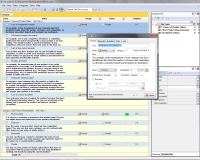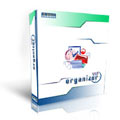|
Task Management Software |
 |
|
|
|
|
| |
|
 TESTIMONIALS TESTIMONIALS
|
|
"...This is an excellent program. I'm so glad that I stumbled on to this when researching for task management programs. Very low learning curv, quite flexible, and the price is right. Tried at least 20 other programs, either too complicated, too expensive, or poor documentation..."
Chad Lindsey -
Honolulu, HI
|
|
|
|
|
|
|
|
Product Evaluation Checklist |
|
|
|
|
|
|

 |
In this Product Evaluation Checklist we provide a list of tasks you can do to review possible causes of product failure, understand how the best product is characterized, and use evaluation criteria for ensuring that your product is developed in a proper way.
|
| Order 750 checklists in MS Word and PDF printable format at $49.99 USD only. |
BUY NOW!  |
Causes of Product Failure.
- Lack of management oversight. For example, senior management of your company may have insufficient data about the market, customers and competition, so decisions on product launch and treatment are inadequate.
- Unforeseen changes in the market. For example, one of your competitors introduces a competing product into the market unexpectedly so your product is no more leading. You should conduct a sound investigation of your competitors and try to foresee their next steps in the short run.
- Lack of deep market appraisals. Your product may have features that are not desirable by target consumers. In order to avoid such situations, you must conduct a market analysis to appraise the target audience and determine the most expected and desirable features.
- Problems and defect. For example, the manufacturing of your product is too costly, complicated or even faulty, so it becomes less cost-effective for you to manufacture the product. In such a case you need to use process improvement methods (e.g. Six Sigma, Business Process Reengineering, etc.) to improve the production process and reduce number of faults and errors.
- Inadequate marketing support. For instance, your company rates the product so high in the market that senior management decides to cut back on promotion. As a result, the product is marketed and advertized poorly. Our suggestion is to develop a consistent marketing strategy that uses adequate product appraisals and estimations to position, promote and support your product in the market.
- Lack of customer recognition. Your customers may not recognize the product because they have no sufficient information about it. You can use advertizing as the primary tool to promote the product and improve customer recognition.
2. Best Product Characterization.
- Pronounceable. Is it easy for a customer to pronounce the product name? Do you use simple words and expressions in the product description?
- Distinctive. Does the name of your product stand out from competitors’ names? Are you sure that your customers are not confused with other names in your niche or similar niches?
- Memorable. Can you say that your customers remember the name of your product accurately? Can they memorize and repeat the name? Is the name free of counterintuitive spelling?
- Flexible. Can you use your product to design sub-products that have an association with the parent product? Do you enjoy flexibility in creating new brands by using the current product?
- Evocative. Can you confirm that the product name has positive associations? Do you use metaphors to make the product evocative?
- Reliable. Are customers satisfied with using your product? Is the product reliable in terms of quality and features?
- Appropriate. Are you sure that your product has a unique name that differs from other brands? Is there an appropriate product description that makes it clear for a customer to understand the product, its feature and how to use it?
- Relevant. Can you tell if there are customers wishing to purpose your product again and again? What is the longevity of your product? Does the product have accessories that help sell up and make repeatable deals?
- Tractable. How difficult will it be for your company to launch or re-launch the product? Is there sense to modify the product?
3. Evaluation Criteria.
- Materials & Ingredients.
- Is the product composed of organic materials and ingredients?
- Are chemical ingredients used?
- Do the materials and ingredients comply with health regulations?
- Are they recyclable and renewable?
- Manufacturing Methods.
- Are chemicals used to manufacture the product?
- Does your company utilize fair trade practices?
- Have you tested the product on animals?
- Is the product made using renewable energy?
- Packaging.
- Is the product packaging minimal or excessive?
- Can the packaging be reused and recycled?
- Are natural ingredients used to manufacture the packaging?
- Manufacturing Place.
- Where do the materials and ingredients originate from?
- Is the product made in a safe, non-toxic and ecological place?
- Are product components assembled in one or multiple locations?
- Use.
- Does the product have application instructions labeled on the packaging?
- What makes the product eco-friendly?
- Can the product be reused?
- Disposal.
| Order 750 checklists in MS Word and PDF printable format at $49.99 USD only. |
BUY NOW!  |
|





 |
CentriQS Tasks Management Solution 
Looking for multi-user task management software? Try CentriQS complete task management solution for planning, tracking and reporting tasks, projects, and schedules. Increase productivity of your small business or office by better organizing your employees' tasks and time.
 FREE Download CentriQS FREE Download CentriQS
|
|
|
|
|
|
|
|
|
|
CentriQS  -15% OFF -15% OFF |
All-in-one business management software
for small and midsize enterprises |
 |
|
|
| VIP Task Manager |
Multi-user project management software
to plan, schedule and track project tasks. |
 |
|
|
| VIP Checklists
|
More than 750 ready-to-use to-do lists
to plan your personal and business life |
 |
|
|
| VIP Team To Do List |
Professional task management software
to make and send team todo lists by email |
 |
|
|
| VIP Organizer |
Personal time management software
to organize time at home and at work |
 |
|
|
| VIP Simple To Do List
|
Simple and effective to-do list software
to plan daily chores, trips, wedding, etc. |
 |
|
|
|
|
|
|
|